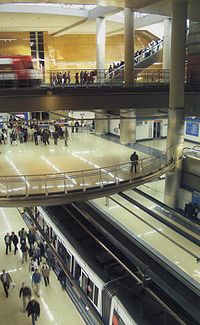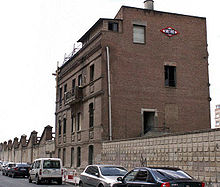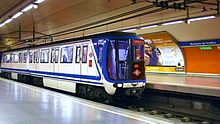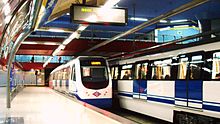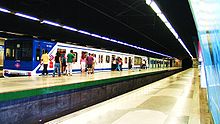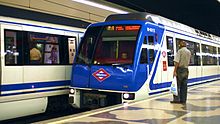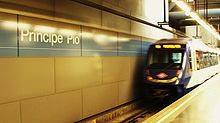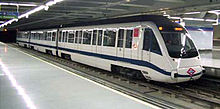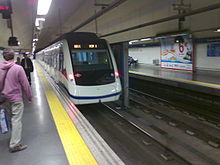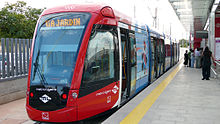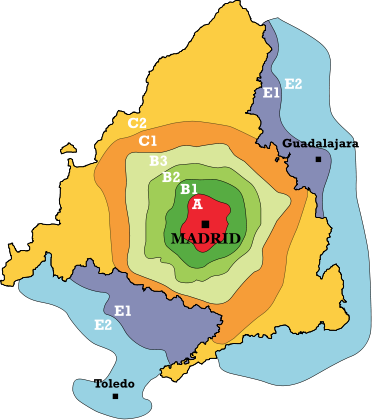- Madrid Metro
-
Madrid Metro 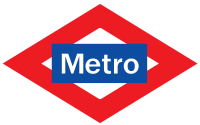
Info Locale Madrid Transit type Rapid transit Number of lines 13 Number of stations 272 Daily ridership 627 million/year Operation Began operation 1919 Number of vehicles 2404 Technical Track gauge 1,445 mm (4 ft 8.9 in) Madrid Light Metro 
Info Locale Madrid Transit type Light rail / Tramway Number of lines 3 Number of stations 38 Operation Began operation 2007 Technical 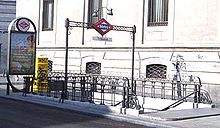 Typical Madrid metro entrance, designed by Antonio Palacios, at Tribunal station
Typical Madrid metro entrance, designed by Antonio Palacios, at Tribunal station
The Madrid Metro (Spanish: Metro de Madrid) is a metro system serving the city of Madrid, capital of Spain. The system is the sixth longest metro in the world[2] though Madrid is approximately the fiftieth most populous metropolitan area in the world. Its fast growth in the last 20 years has also put it among the fastest growing networks in the world, rivaled by many Asian metros such as the Delhi Metro, Shanghai Metro, Guangzhou Metro or the Beijing Subway. Unlike normal Spanish road and rail traffic, Madrid Metro trains use left-hand running on all lines due to historical reasons.
A light rail system feeding the metro opened in 2007 called Metro Ligero (light metro).[3]
Contents
History
The first line of the Madrid metro opened on 17 October 1919 under the direction of the Compañía de Metro Alfonso XIII, with 8 stations and 3.5 km (2.2 mi). It was constructed in a narrow section and the stations had 60 m platforms. The enlargement of this line and the construction of two others followed shortly after 1919. In 1936, the network had three lines and a branch line between Opera and Norte railway station. All these stations served as air raid shelters during the Spanish Civil War.
After the civil war the public works to extend the network went on little by little. In 1944 a fourth line was constructed and it absorbed the branch of line 2 between Goya and Diego de León in 1958, a branch that had been intended to be part of line 4 since its construction but was exploited as a branch of line 2 until the construction of line 4.
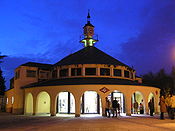 Lago station in the old Line S (now Line 10) is one of the few surface stations in the Metro network.
Lago station in the old Line S (now Line 10) is one of the few surface stations in the Metro network.
In the sixties, a suburban railway was constructed between Plaza de España and Carabanchel, linked to lines 2 (at Noviciado station with a long transfer) and 3. A fifth metro line was constructed as well with narrow section but 90 m platforms. Shortly after opening the first section of line 5, the platforms in line 1 were enlarged from 60 to 90 m, closing Chamberí station since it was too close to Iglesia (less than 500 m). Chamberí has been closed ever since and has recently been opened as a museum.
At the beginning of the seventies, the network was greatly expanded to cope with the influx of population and urban sprawl from Madrid's economic boom. New lines were planned with large 115 m platforms. Lines 4 and 5 were enlarged as well. In 1979, bad management led to a crisis. Works already started were finished during the eighties and all remaining projects were abandoned. After all those projects, 100 km (62 mi) of rail track had been completed and the suburban railway had also disappeared since it had been extended to Alonso Martínez and thence converted to line 10.
At the beginning of the nineties, control of the network was transferred to a public enterprise, Metro de Madrid. More large-scale expansion projects were carried out. Lines 1, 4 and 7 were extended and a new line 11 was constructed towards the outlying areas of Madrid. Lines 8 and 10 were joined together into a longer line 10 and a new line 8 was constructed to expand the underground network towards the airport. The enlarged line 9 was the first to leave the outskirts of Madrid to arrive in Rivas-Vaciamadrid and Arganda del Rey, two towns located in the southeast suburbs of Madrid.
In the early 2000s, a huge project installed approximately 50 km (31 mi) of new metro tunnels. This construction included a direct connection between downtown Madrid (Nuevos Ministerios) and the airport, the lengthening of line 8, and adding service to the outskirts with a huge 40 km loop called MetroSur serving Madrid's southern suburbs.
MetroSur, one of the largest ever civil engineering projects in Europe, opened on 11 April 2003. It includes 41 km (25 mi) of tunnel and 28 new stations, including a new interchange station on Line 10, which connects it to the city centre and stations linking to the local train network. Its construction began in June 2000 and the whole loop was completed in less than three years. It connects Getafe, Móstoles, Alcorcón, Fuenlabrada, and Leganés, five towns located in the area south of Madrid.
Most of the current efforts of Madrid regional government are channeled towards the enlargement of the Metro network. In the recently finished 2003-2007 term, President Esperanza Aguirre funded a multi-billion dollar project, which has added to, joined, or extended almost all of the metro lines. The project included the addition of 90 km (56 mi) and the construction of 80 new stations. It has carried the underground railway to many districts that had never previously had Metro service (Villaverde, Manoteras, Carabanchel Alto, La Elipa, Pinar de Chamartín) and to the eastern and northern outskirts as well (Coslada, San Fernando de Henares, Alcobendas, San Sebastián de los Reyes). For the first time in Madrid, 3 interurban light rail (Metro Ligero or ML) lines were built to the western outskirts (Pozuelo de Alarcón, Boadilla del Monte) - mL2 and mL3 - and to the new northern districts of Sanchinarro and Las Tablas - mL1. As a last-minute addition, a project on line 8 connected it to the new T4 terminal of Madrid-Barajas Airport.
Future expansion
The Metro Authority closed sections of Line 6 during the summer of 2009 in order to install rigid overhead lines (see below) and install a new train control and signalling system that will reduce wait times and improve train circulation. Line 6 re-opened in mid-September 2009 along its entire length.
There are numerous expansion and improvement projects pending; many suspended due to the current financial crisis (as of 2010). For example, lines 1 and 5 reaching Valdebebas, extending line 11 further North towards Atocha railway station and beyond, as well as extending line 9 to the North, opening the station Arroyo del Fresno on line 7 and extending line 3 further South.
Station design and setup
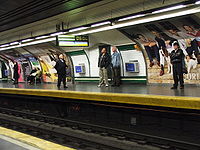 Alonso Martínez station in Line 4: old stations are often compact, and usually not too deep underground
Alonso Martínez station in Line 4: old stations are often compact, and usually not too deep underground Getafe Central in Line 12, with a Cercanías transfer: new stations are built deliberately ample, with several, cross-visible levels and elevators for disabled people.
Getafe Central in Line 12, with a Cercanías transfer: new stations are built deliberately ample, with several, cross-visible levels and elevators for disabled people.
Stations in the Madrid metro reveal their age in their design: older stations on the narrow lines are often quite compact, rather like the stations on the Paris Metro. They were decorated with tilings in different colour schemes depending on the station. In recent years, most of these stations have been refurbished with single coloured plates matching those in the newest ones. The stations built between the late 70s and the early 90s are slightly more spacious and most of them have cream colored walls.
On the other hand, the most recent stations are built with space in mind, and are considered[who?] amongst the best in the world for their natural-like lighting and ample entryways.[citation needed] The colour scheme varies between stations, using single-colored plates and covering the whole station in light colors. Recently built transfer stations have white walls, but this is not the norm.
Most stations are built with two side platforms, and a handful of them (the busiest transfers) have a central island platform in addition to the side platforms theoretically dedicated to exits. This system was originally used on the Barcelona Metro and is called the Spanish solution. Stations with this setup include:
- Line 2 Cuatro Caminos
- Line 4 Argüelles
- Line 5 Campamento, Carabanchel
- Line 6 Avenida De América, Manuel Becerra, Sáinz De Baranda, Pacífico, Plaza Elíptica, Oporto, Laguna
- Line 7 Avenida De América, Pueblo Nuevo
Some stations have cross-platform interchange arrangement which allows extremely fast transfers between two lines. The only stations with this setup are Príncipe Pío (


 ) and Casa de Campo (
) and Casa de Campo (
 ). On both occasions, Line 10 uses the outside tracks, so passengers unboarding there leave through the "right" side of the train instead of the usual left side.
). On both occasions, Line 10 uses the outside tracks, so passengers unboarding there leave through the "right" side of the train instead of the usual left side.In addition, a few stations are built with just one island platform instead of the usual side platforms. These stations are:
- Line 3 Almendrales, Villaverde Alto
- Line 5 Aluche
- Line 8 Campo De Las Naciones, Aeropuerto T4
- Line 9 Rivas Urbanizaciones, Arganda del Rey
- Line 10 Joaquin Vilumbrales
Another system is where there is one island platform with one side platform. This system is used in the stations on Lines 7, 9 & 10 where it is required for passengers to change to smaller trains to continue their journeys, normally to towns outside Madrid like Alcobendas or Coslada. This is done so the island platform can be used for passengers to change easily between trains. These stations are:
Overhead Power Supply
Since 1999 Metro de Madrid uses a new patented system for its installations: a solid track hung from the ceiling of the tunnels, instead of the usual copper or aluminium wire. This type of catenary (or overhead line) is rigid, making it more robust and less prone to failures. Installations outside of tunnels are rare, as they require many more support structures compared to traditional wire based overhead lines, making them more expensive to install.
This system of rigid overhead power supply is also used elsewhere.
Lines
The Metro network has 231 stations on 12 lines plus one branch line, totalling 282 km, of which approximately 92% is underground.[citation needed] The only surface parts are: Campamento-Eugenia de Montijo (
 ), Lago-Casa de Campo (
), Lago-Casa de Campo ( ) and Puerta de Arganda-Arganda del Rey (
) and Puerta de Arganda-Arganda del Rey ( ). Additionally, some 30 km of Metro Ligero (modern tram) lines serve the various regions of the metropolitan area which have been deemed not populated enough to justify the extraordinary spending of new Metro lines. Most of the ML track length is on surface, usually running on platforms separated from normal road traffic. However, ML1 line has some underground stretches and stations. Traditionally, the Madrid metro was restricted to the city proper, but today nearly one third of its track length runs outside the border of the Madrid municipality. Today, the Metro network is divided in five regions:
). Additionally, some 30 km of Metro Ligero (modern tram) lines serve the various regions of the metropolitan area which have been deemed not populated enough to justify the extraordinary spending of new Metro lines. Most of the ML track length is on surface, usually running on platforms separated from normal road traffic. However, ML1 line has some underground stretches and stations. Traditionally, the Madrid metro was restricted to the city proper, but today nearly one third of its track length runs outside the border of the Madrid municipality. Today, the Metro network is divided in five regions:- MetroMadrid (zone A): the core network inside the Madrid city borders, with over two thirds of the overall length. Also includes the light rail line
 .
. - MetroSur (zones B1 and B2): line
 and the last two stations of line
and the last two stations of line  , Joaquín Vilumbrales and Puerta del Sur. Runs through the southern cities of Alcorcón, Leganés, Getafe, Fuenlabrada and Móstoles.
, Joaquín Vilumbrales and Puerta del Sur. Runs through the southern cities of Alcorcón, Leganés, Getafe, Fuenlabrada and Móstoles. - MetroEste (zone B1): a prolongation of line
 from Estadio Olímpico to Hospital de Henares through the municipalities of Coslada and San Fernando de Henares.
from Estadio Olímpico to Hospital de Henares through the municipalities of Coslada and San Fernando de Henares. - MetroNorte (zone B1): opened in 2007, includes the stretch of line
 from La Granja to Hospital Infanta Sofía. Services the northern outskirts of Madrid and the towns of Alcobendas and San Sebastián de los Reyes. There is a train interchange inside the line at Tres Olivos station.
from La Granja to Hospital Infanta Sofía. Services the northern outskirts of Madrid and the towns of Alcobendas and San Sebastián de los Reyes. There is a train interchange inside the line at Tres Olivos station. - MetrOeste (zones B1 and B2): comprised by the Metro Ligero lines
 and
and  . Connects the towns of Pozuelo de Alarcón and Boadilla del Monte to line
. Connects the towns of Pozuelo de Alarcón and Boadilla del Monte to line  at Colonia Jardín station.
at Colonia Jardín station. - TFM (zones B1, B2 and B3): a prolongation of line
 from Puerta de Arganda, the first ever outside the borders of Madrid, services the cities of Rivas-Vacíamadrid and Arganda del Rey.
from Puerta de Arganda, the first ever outside the borders of Madrid, services the cities of Rivas-Vacíamadrid and Arganda del Rey.
At most of the borders between the regions, one has to switch trains even when staying in the same line, because the train frequency is higher in the core MetroMadrid than in the outer regions.
Madrid also has an extensive commuter train (Cercanías) network operated by Renfe, the national rail line, which is intermodal with the metro network. In fact, 22 Cercanías stations have connections to the Metro network, which is indicated on the official map by the Cercanías logo. Many of the new lines since 1999 have been built to link to or end at Cercanías stations, like the ML2 line, which ends at the Aravaca station providing a fast entry into Madrid though the C-7 or C-10 commuter lines and arriving in only one step to the bus and Metro hub Príncipe Pío (


 ).
).See also the list of Madrid metro stations.
Line Terminus Length Stations Loading gauge Platform Main service by Configuration 
Pinar de Chamartín – Valdecarros 23.876 km (14.8 mi) 33 narrow 90 m CAF s. 2000-A M.R-M.R-R.M 
Las Rosas – Cuatro Caminos 14.031 km (8.7 mi) 20 60 m CAF s. 3000 MRRM 
Villaverde Alto – Moncloa 16.424 km (10.2 mi) 18 90 m CAF s. 3000 MRSSRM 
Argüelles – Pinar de Chamartín 16.0 km (9.9 mi) 23 60 m CAF s. 3000 MRRM 
Alameda de Osuna – Casa de Campo 23.217 km (14.4 mi) 32 90 m CAF s. 2000-B M.R-M.R-R.M 
Circular 23.472 km (14.6 mi) 28 wide 115 m CAF s. 5000 M.M-M.M-M.M 
Hospital del Henares – Estadio Olímpico – Pitis 32.919 km (20.5 mi) 30 AnsaldoBreda s. 9000 MRSSRM 
Nuevos Ministerios – Aeropuerto T4 16.467 km (10.2 mi) 8 CAF s. 8000 MRSM 
Mirasierra – Puerta de Arganda – Arganda del Rey 39.5 km (24.5 mi) 28 CAF s. 6000 & 8000 MRM-MRM 
Hospital Infanta Sofía – Tres Olivos – Puerta del Sur 36.514 km (22.7 mi) 31 AnsaldoBreda s. 7000 MRSSRM 
Plaza Elíptica – La Fortuna 8.5 km (5.3 mi) 7 CAF s. 3000 MRSSRM 
MetroSur 40.96 km (25.5 mi) 28 CAF s. 8000 MRM-MRM 
Ópera – Príncipe Pío 1.092 km (0.7 mi) 2 narrow 60 m CAF s. 3000 M.R-R.M ML 
Pinar de Chamartín – Las Tablas 5.395 km (3.4 mi) 9 tramway 32 m Alstom Citadis 302 MRRRM ML 
Colonia Jardín – Estación de Aravaca 8.680 km (5.4 mi) 13 ML 
Colonia Jardín – Puerta de Boadilla 13.699 km (8.5 mi) 16 - Notes
- Line
 is a shuttle service (R stands for "ramal" = "branch")
is a shuttle service (R stands for "ramal" = "branch") - Old stations are not accessible to people with disabilities but since 1995 all new stations must be accessible by law. Thus, both new stations and renewed old ones have elevators for people on wheelchairs, huge signs for the visually impaired, etc.
- All narrow loading gauge lines except line
 had originally 60m platforms. Line
had originally 60m platforms. Line  was the first to have theirs extended to 90m, while line
was the first to have theirs extended to 90m, while line  had to wait until the 2000s: prior to its recent extension to the southern district of Villaverde, it was completely closed for nearly a year and thoroughly renewed. Thus, one of the worst lines of the network, both in terms of trains and facilities, became the shiniest between the narrow-gauged, and was the first to receive the all-new Construcciones y Auxiliar de Ferrocarriles Series 3000 trains.
had to wait until the 2000s: prior to its recent extension to the southern district of Villaverde, it was completely closed for nearly a year and thoroughly renewed. Thus, one of the worst lines of the network, both in terms of trains and facilities, became the shiniest between the narrow-gauged, and was the first to receive the all-new Construcciones y Auxiliar de Ferrocarriles Series 3000 trains. - Configurations: M - engine (Motor), R - passive (Remolque), S - cabless engine (motor Sin cabina). Dots/dashes mean crossable/complete basic unit separation, while their absence implies a walkable aisle throughout the joined units.
- Alstom Citadis 302 tramways have one motor "car", one suspended, one with bogie but without motors, one suspended, one motor.
Rolling stock
Traditionally, the trains operating in the Madrid Metro have been built and supplied by the Spanish company Construcciones y Auxiliar de Ferrocarriles (CAF). This was particularly true under Francisco Franco's dictatorship, due to the politic of autarchy his administration initially pursued. However, in recent years the Italian Ansaldobreda has also provided trains for the wide-profile lines.
Every rolling unit in the Madrid Metro has a unique ID that singles it out in the whole network. Those IDs are grouped by the rolling unit model (the "series") and thus is used to categorize the trains, as they bear no user-visible statement of the model specified by the manufacturer. An ID is made up of:
- A letter indicating the type of rolling unit: M for a car with both engines and driver's cabin (Spanish Motor), R for an engineless car, with or without drivers cabin (Spanish Remolque) and S for a cabinless car with engines (Spanish motor Sin cabina).
- A dash separating the two components
- A three or four digit number indicating the unit's series and the position within it. Usually, the series is indicated by the thousands and hundreds (i.e. 5281 indicates a series 5000, subseries 200 train).
Trainsets currently in use
Narrow profile
- CAF series 2000: This series has two separate sub-series usually called A and B. The first batch, while reliable and practical, was extremely "box-like" in its looks. They are nicknamed 'Pandas', after a car by Seat with the same name and similar boxy design. In contrast, the B sub-series train sets can be told apart by its sleeker, rounder forms, which has granted them the nickname of "bubble" (Spanish burbuja) for their round driver cabin window. Series 2000A are currently the more numerous in the network: 530 cars[4] were built and delivered between 1985 and 1993,[5] having serviced every narrow profile line. They are also among the oldest stock in operation in the Madrid Metro, so some of them (namely, those servicing lines
 and
and  ) have been scheduled for retirement with the purchase of newer series 3000 sets. However, the most reliable ones are being refurbished and painted with new, lighter colors like the ones used in Series 3000, and will continue to service line
) have been scheduled for retirement with the purchase of newer series 3000 sets. However, the most reliable ones are being refurbished and painted with new, lighter colors like the ones used in Series 3000, and will continue to service line  for the time being. Series 2000B were delivered in lesser numbers (about 126 cars) between 1997 and 1998,[6] with the inclusion of air conditioning and station announcements through pre-recorded voice messages and LED displays. They are currently used in line
for the time being. Series 2000B were delivered in lesser numbers (about 126 cars) between 1997 and 1998,[6] with the inclusion of air conditioning and station announcements through pre-recorded voice messages and LED displays. They are currently used in line  , with no plans for retirement.
, with no plans for retirement.
- CAF series 3000: The newest of the narrow line trainsets, series 3000 were commissioned for the reopening of line
 after its complete renewal in the early 2000s. Their constituent subunits can be completely joined through crossable articulations, making it possible to go from the head to the tail without actually exiting the train. This has earned them the nickname of "boa", a term usually applied in Spain to double-length buses with such joints. They are currently servicing lines
after its complete renewal in the early 2000s. Their constituent subunits can be completely joined through crossable articulations, making it possible to go from the head to the tail without actually exiting the train. This has earned them the nickname of "boa", a term usually applied in Spain to double-length buses with such joints. They are currently servicing lines  and
and  , but newer purchases are also scheduled to replace the trains in lines
, but newer purchases are also scheduled to replace the trains in lines  and
and  before 2010. Series 3000 trains look rather like a narrowed version of series 8000, while the interior uses mainly yellow and light blue tones.
before 2010. Series 3000 trains look rather like a narrowed version of series 8000, while the interior uses mainly yellow and light blue tones.
Wide profile
- CAF series 5000: Currently servicing line
 , this model has had a long history: the first trainsets were delivered in 1974[7] for the newly-opened, first wide-profile line
, this model has had a long history: the first trainsets were delivered in 1974[7] for the newly-opened, first wide-profile line  , while the latest subseries, 5500, of which 24 trainsets of 6 cars each were built, entered service in 1993.[8] They were the last to use the old, square "box-like" design from CAF, which was already becoming unpopular for its exaggerate priming of effectiveness versus aesthetics. The first iteration featured a wood lookalike coating for the inner walls and a novel seat distribution in two-seat rows perpendicular to the train walls, making them look not unlike older regional trains. Subseries 5100-5200 returned to the traditional seating along the train walls, but still included another feature from the first iteration, automatic opening of all the gates in the train. The final subseries, 5500, has a distinct, darker color scheme and returns to the usual on-demand opening of train gates with a button on each one. Being the oldest rolling stock in operation in the wide profile lines, this series is scheduled for replacement by the newer Ansaldobreda series 9000 in 2008-2009, while negotiations are open for its sale to the Buenos Aires Metro.
, while the latest subseries, 5500, of which 24 trainsets of 6 cars each were built, entered service in 1993.[8] They were the last to use the old, square "box-like" design from CAF, which was already becoming unpopular for its exaggerate priming of effectiveness versus aesthetics. The first iteration featured a wood lookalike coating for the inner walls and a novel seat distribution in two-seat rows perpendicular to the train walls, making them look not unlike older regional trains. Subseries 5100-5200 returned to the traditional seating along the train walls, but still included another feature from the first iteration, automatic opening of all the gates in the train. The final subseries, 5500, has a distinct, darker color scheme and returns to the usual on-demand opening of train gates with a button on each one. Being the oldest rolling stock in operation in the wide profile lines, this series is scheduled for replacement by the newer Ansaldobreda series 9000 in 2008-2009, while negotiations are open for its sale to the Buenos Aires Metro. -
CAF series 6000:This model, of which 29 trainsets were built and delivered in 1998,[9] was the first by CAF to feature a new, sleeker and rounder design. As it was to serve TFM, the stretch of line
 connecting Madrid to Arganda del Rey (the first extension of the Metro network outside Madrid proper), its interior resembles the regional Cercanías trains more closely than any other Metro trains: compact seats in couples set perpendicularly to the train walls, more places to grasp in case of a sudden brake/acceleration, etc. They were also the first to include luminous panels stating their destination, as the line they service was effectively split in two stretches, and travellers had to switch trains at Puerta de Arganda. Finally, they primed the "boa train" layout (see CAF s.3000), but the walkable aisle only spanned two cars, while a trainset would usually carry 4 or 6. Series 6000 is currently the main service for line
connecting Madrid to Arganda del Rey (the first extension of the Metro network outside Madrid proper), its interior resembles the regional Cercanías trains more closely than any other Metro trains: compact seats in couples set perpendicularly to the train walls, more places to grasp in case of a sudden brake/acceleration, etc. They were also the first to include luminous panels stating their destination, as the line they service was effectively split in two stretches, and travellers had to switch trains at Puerta de Arganda. Finally, they primed the "boa train" layout (see CAF s.3000), but the walkable aisle only spanned two cars, while a trainset would usually carry 4 or 6. Series 6000 is currently the main service for line  .
.
- Ansaldobreda series 7000 & 9000: The first purchase to a manufacturer other than CAF, and to a non-Spanish dealer, 37 series 7000 trainsets service the extremely busy line
 , while occasionally venturing out into line
, while occasionally venturing out into line  for rush hour support. They were the first in the network to feature a full "boa" layout, allowing commuters to traverse the whole six cars. They are extremely functional, with ample 1.3m doors and a sleek, unobtrusive design for a total capacity of 1,260 people per trainset (180 seated). This model also features two TV screens in each car, but they are left unused, both regularly or in emergencies. Series 9000 trains are similar to their previous incarnation, but include better accesses for disabled people and more safety measures, such as visual and auditive warnings for the train gates and more effective emergency brakes. Series 7000 currently service the main part of line
for rush hour support. They were the first in the network to feature a full "boa" layout, allowing commuters to traverse the whole six cars. They are extremely functional, with ample 1.3m doors and a sleek, unobtrusive design for a total capacity of 1,260 people per trainset (180 seated). This model also features two TV screens in each car, but they are left unused, both regularly or in emergencies. Series 9000 trains are similar to their previous incarnation, but include better accesses for disabled people and more safety measures, such as visual and auditive warnings for the train gates and more effective emergency brakes. Series 7000 currently service the main part of line  , from Puerta del Sur to Tres Olivos; while series 9000 comprise the main fleet of line
, from Puerta del Sur to Tres Olivos; while series 9000 comprise the main fleet of line  , the part of
, the part of  from Tres Olivos to Hospital Infanta Sofía, and are occasionally used for rush hour support on
from Tres Olivos to Hospital Infanta Sofía, and are occasionally used for rush hour support on  . The next batch has already started entering service on line
. The next batch has already started entering service on line  before 2009, replacing the part of the 15-year-old CAF 5000 fleet.
before 2009, replacing the part of the 15-year-old CAF 5000 fleet.
-
CAF series 8000: Originally designed for the MetroSur line
 , 45 trainsets were built and delivered by CAF in 2002.[10] Each one is composed of three cars joined in the "boa" layout, which service line
, 45 trainsets were built and delivered by CAF in 2002.[10] Each one is composed of three cars joined in the "boa" layout, which service line  as-is, while MetroSur service uses two such trainsets to form a MRM-MRM configuration for a maximum of 1,070 passengers (144 seated). The interior distribution is rather like that of series 7000, with a bigger clear area (i.e. without seating) in the first car for people carrying luggage to/from the airport and disabled people in wheelchairs. Like the narrower series 3000 trainsets, its bogies are insonorized and feature a hybrid rubber-pneumatic suspension system. Series 8000 primed the introduction of regenerative braking in the Madrid Metro. The system reverses the normal circuit of the electric motors when braking, thus making the deceleration return power to the network. Also, they feature the now-standard informative panels and gate activity warnings in the interior. This model has a stable population, which neither purchases nor retirements planned as of 2008[update], though as the most current model from CAF it remains on the table for future enlargements of the Metro network. It currently services lines
as-is, while MetroSur service uses two such trainsets to form a MRM-MRM configuration for a maximum of 1,070 passengers (144 seated). The interior distribution is rather like that of series 7000, with a bigger clear area (i.e. without seating) in the first car for people carrying luggage to/from the airport and disabled people in wheelchairs. Like the narrower series 3000 trainsets, its bogies are insonorized and feature a hybrid rubber-pneumatic suspension system. Series 8000 primed the introduction of regenerative braking in the Madrid Metro. The system reverses the normal circuit of the electric motors when braking, thus making the deceleration return power to the network. Also, they feature the now-standard informative panels and gate activity warnings in the interior. This model has a stable population, which neither purchases nor retirements planned as of 2008[update], though as the most current model from CAF it remains on the table for future enlargements of the Metro network. It currently services lines  and
and  , while also providing rush hour support to lines
, while also providing rush hour support to lines  and
and  .
.
-
CAF series 8400: Derived from the recent series 8000 trains, the 8400 series are the newest train type to enter service on the Madrid Metro on line
 since 2010 to complement the older series 5000 and newer series 9000 trains serving on that line.
since 2010 to complement the older series 5000 and newer series 9000 trains serving on that line.
Light rail (named Metro Ligero)
- Alstom Citadis 302: The vehicles serving the light rail lines are low-floor articulated trams in a five-section "boa" configuration, which allows for a maximum of 450 passengers per tram (60 seated). They can reach a top speed of 100 km/h (65 mph), but in practice they are limited to 70 km/h (45 mph) in most track stretches, and even less in urban sprawls. The tram features a bell-like proximity warning that is activated when the train approaches a station or a level crossing with pedestrians, which has stirred complaints from people living near the tracks for the noise generated. Safety features also include door activity warnings for passengers and emergency brakes comparatively more effective than in any other train dedicated to Metro service, as the trams, though remaining in their own lanes separated from other traffic, can cross roads and populated areas.
Historic rolling stock
Until the early 1990s and the transfer of the Metro system to the Autonomous Community of Madrid, the rate of investment in the network by the central government was extremely low,[11] and thus very old trains were used way beyond their intended lifespans. Particularly loathed was the case of line
 , which was serviced by the nearly 40-year-old series 300 and 1000 from CAF. It was not uncommon that a child would ride to school on the same train his/her parents took decades earlier. Some renewals, along with the purchases of series 2000A and 5000, were started by the socialist regional government of Joaquín Leguina, but in 1995 the People's Party took over the government with the promise to widely extend and improve the Metro service. New lines were built and old ones refurbished: line
, which was serviced by the nearly 40-year-old series 300 and 1000 from CAF. It was not uncommon that a child would ride to school on the same train his/her parents took decades earlier. Some renewals, along with the purchases of series 2000A and 5000, were started by the socialist regional government of Joaquín Leguina, but in 1995 the People's Party took over the government with the promise to widely extend and improve the Metro service. New lines were built and old ones refurbished: line  service was disturbed for several years as some stations at a time were closed and refitted, while line
service was disturbed for several years as some stations at a time were closed and refitted, while line  was closed for two consecutive summers in order to expand its platforms to 90m. Then, new rolling stock was also requested: 1998 saw the arrival of the first CAF series 2000B, retiring the infamous series 1000. Initially the better-preserved series 300 were refitted and painted in the new blue-white color scheme (from the old red corporate image), but they were also retired with the arrival of more series 2000B and, finally, series 3000.
was closed for two consecutive summers in order to expand its platforms to 90m. Then, new rolling stock was also requested: 1998 saw the arrival of the first CAF series 2000B, retiring the infamous series 1000. Initially the better-preserved series 300 were refitted and painted in the new blue-white color scheme (from the old red corporate image), but they were also retired with the arrival of more series 2000B and, finally, series 3000.Fares
The Madrid Metro network is split into the six "functional" zones mentioned above. Each one has a "single" ticket (Billete Sencillo), valid for one trip within the zone, and a 10-trip ticket for a comparatively lower price. When crossing zone boundaries, one has to buy a new ticket for the zone being entered. There is also a "combined" ticket, which provides for a single trip between any two points of the network except the Airport stations, which have an additional supplement of €1. All in all, it is possible to go from the airport to any other point of the network for €3.00.
Also, the Consorcio Regional de Transportes (Regional Transportation Authority) has a division of its own, with geographic zones named A through C2. This body sells monthly and annual passes for unlimited trips within their zone of validity, and also a range of Tourist Passes for 1, 3, 5 or 7 days. All of them are accepted at the Metro stations within their zones, and passengers using a CRT pass do not have to pay the airport supplement.
Name Valid for Expires after Price MetroX Sencillo MetroX zone 1 trip €1.50 Metrobús MetroMadrid and EMT buses 10 trips €9.30 MetroX 10 viajes MetroX Sencillo Combinado Whole network 1 trips €2.00 Abono Transportes Joven A - C2 (<23 y.o.) One calendar month €29.50 - €52.10 Abono Transportes Normal A - C2 €46.00 - 83,50 € Abono Transportes 3ª Edad A - C2 (>65 y.o.) €10.90 Abono Transportes Anual Normal A - C2 One calendar year €506.00 - €918.50 Abono Transportes Anual 3ª Edad A - C2 (>65 y.o.) €119.90 Abono Turístico A 1 – 7 days €5.20 - €23.60 Abono Turístico T (all CRT zones) €10.40 - €47.20 Operators
The metro is operated by its own company, under the Department of Public Works, City Planning, and Transportation of the autonomous community of Madrid. The passage between Puerta de Arganda (Line 9) and Arganda del Rey (Line 9) is operated by Transportes Ferroviarios de Madrid (TFM). All of Madrid's rapid transit systems are members of the Consorcio Regional de Transportes, which sells monthly passes for unlimited use of the metro, bus and commuter train networks within the area covered by the pass.
See also
- Barcelona Metro
- Bilbao Metro
- Palma de Mallorca Metro
- Seville Metro
- Valencia Metro
- List of metro systems
Notes
- ^ "Metro De Madrid Figures". Metro De Madrid Official Website. http://www.metromadrid.es/en/conocenos/infraestructuras/red/index.html. Retrieved 2011-03-28.
- ^ http://www.citymayors.com/transport/madrid-metro.html Madrid Metro: A thoroughly modern urban rail system
- ^ Von Mach, Stefan (March 2008). "Madrid Light Rail: Three lines to feed the metro". Metro Report International, of Railway Gazette International (UK).
- ^ Trainset sizes vary between lines: 90m lines use six cars per train, while 60m lines use only four. Thus the actual number of trains varies between 88 and 132.
- ^ CAF description for s.2000A (reversed, title says 2000B)
- ^ CAF description for s.2000B (reversed, title says 2000)
- ^ Andén 1 - Historia del Metro
- ^ CAF description for s.5000 - sales information and photos correspond to subseries 5500
- ^ CAF description for s.6000
- ^ CAF description for s.8000
- ^ A similar case happens as of 2008[update] with the Cercanías commuter network, as the Spanish government is focused in the expansion of the nationwide AVE high speed network
External links
- Schematic map of the Metro network ((from the official site, in Spanish))
- Metro de Madrid (official site, in Spanish)
- UrbanRail.net/Madrid
- Consorcio Regional de Transportes de Madrid
- Andén 1 - Association of friends of Madrid Metro
- ENGLISH User guide, ticket types, airport supplement and timings
- Madrid Metro+railway Map. Bilingual Spanish/English. Updated October 2007PDF (750 KiB)
- Network map (real-distance)
Madrid Metro: Rapid transit in Madrid Metro Lines 
Related topics Rail transport in Spain Operators AVE · RENFE · FEVE · EuskoTren · Ferrocarril de Sóller · Serveis Ferroviaris de Mallorca · Ferrocarrils de la Generalitat Valenciana · Ferrocarrils de la Generalitat de Catalunya · Acciona · COMSA Rail TransportCommuter lines Metro/Light rail Alicante · Barcelona Metro · Barcelona Tram · Bilbao Metro · Bilbao Tram · Madrid · Valencia · Málaga · Granada · Jaén · Vitoria-Gasteiz · Palma de Mallorca · Seville · Tenerife · Parla · Vélez-Málaga · Zaragoza TramCategories:- Madrid Metro
- Rail transport in Spain
- Transport in Madrid
- Underground rapid transit in Spain
- Rapid transit in Spain
Wikimedia Foundation. 2010.


